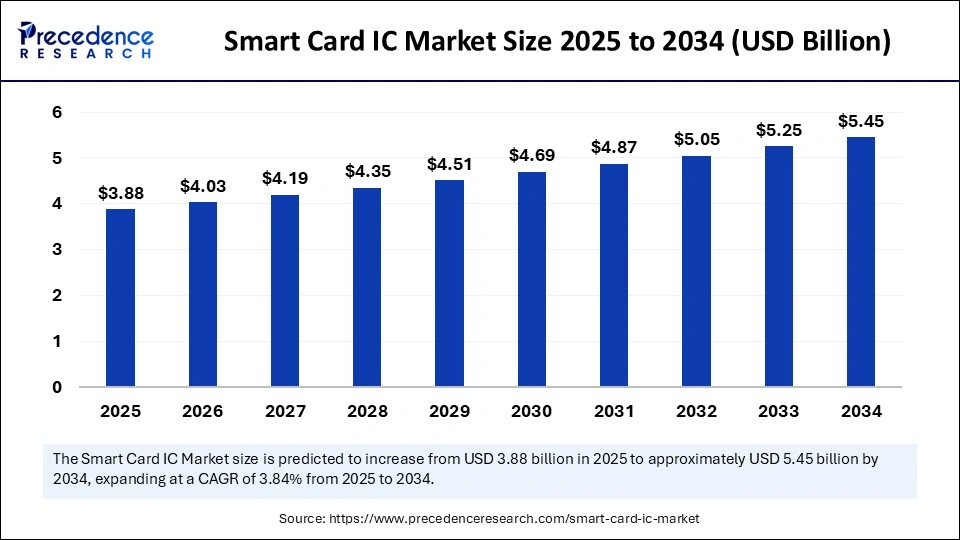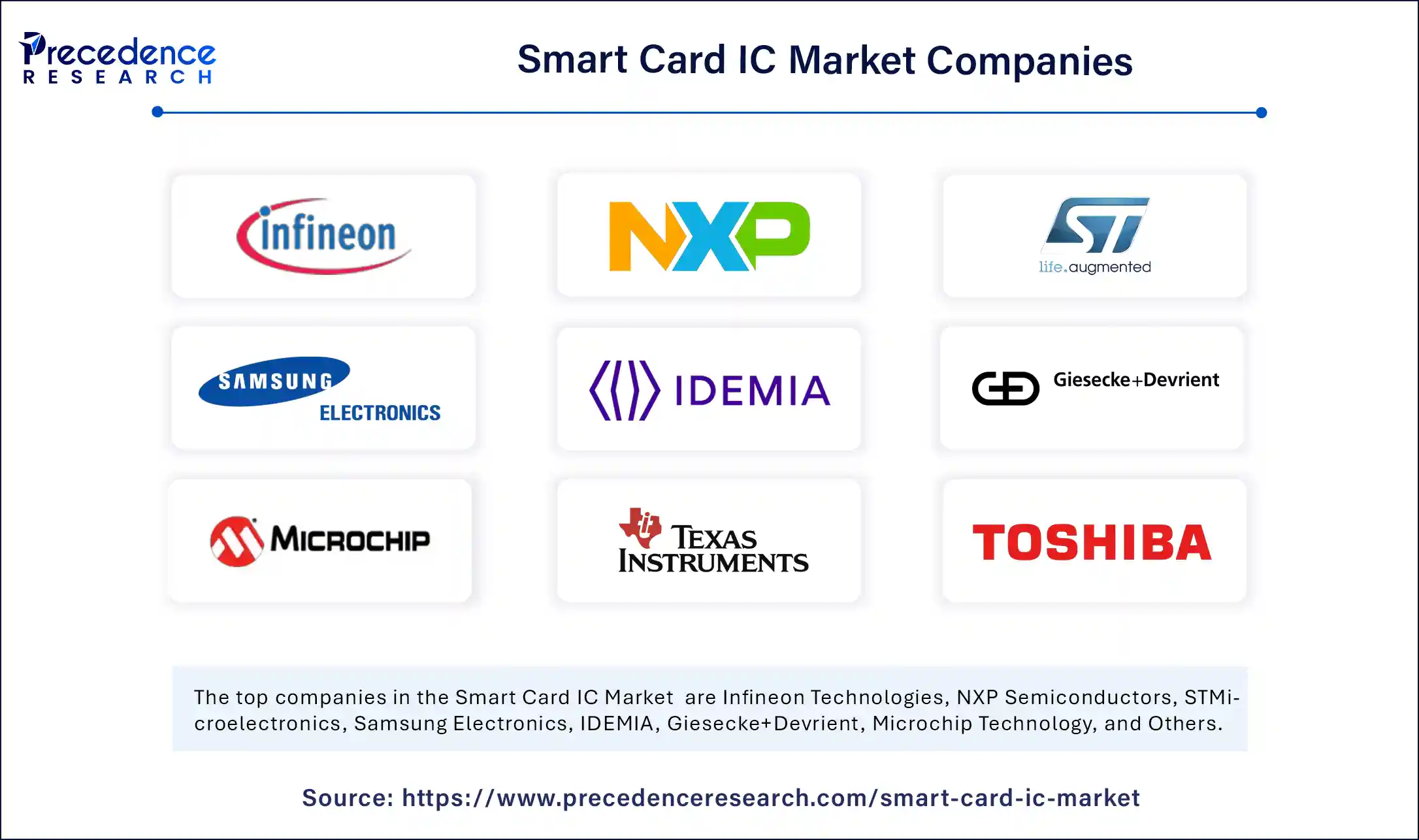The global smart card IC market size is valued to reach around USD 5.45 billion by 2034 increasing from USD 3.74 billion in 2024, with a CAGR of 3.84%.

Smart Card IC Market Key Takeaways
- In terms of revenue, the smart card IC market is valued at $3.88 billion in 2025.
- It is projected to reach $5.45 billion by 2034.
- The market is expected to grow at a CAGR of 3.84% from 2025 to 2034.
- Asia Pacific dominated the global smart card IC market with the largest revenue share in 2024.
- North America is expected to grow at the fastest CAGR from 2025 to 2034.
- By type, the contactless segment held the major revenue share in 2024.
- By type, the contact segment is expected to grow at the highest CAGR during the projection period.
- By architecture, the 16-bit segment dominated the market in 2024.
- By architecture, the 32-bit segment is expected to expand at the fastest CAGR between 2025 and 2034.
- By configuration, the microprocessor-based cards segment contributed the biggest market revenue share in 2024.
- By configuration, the hybrid smart cards segment is expected to expand at a significant CAGR in the coming years.
- By application, the ID cards segment contributed the biggest revenue share in 2024.
- By end-user, the government segment dominated the market in 2024.
- By end-user, the healthcare segment is expected to grow at a significant CAGR over the projected period.
AI Impact on the Smart Card IC Market
-
Smart, secure chips: Smart card ICs use AI to enable encrypted authentication, fraud detection, and anomaly spotting directly on the chip.
-
Predictive reliability: Built‑in AI monitors performance and predicts faults ahead of time—boosting uptime and deployment efficiency.
-
Tailored user experience: AI personalization through in‑card biometrics or user‑specific authentication logic increases accuracy, flexibility, and overall user satisfaction.
Market Overview
The Smart Card IC Market is evolving beyond transaction chips into a broader identity and connectivity platform. Early applications in SIM cards and financial transactions remain dominant, but new use cases in e-governance, healthcare, enterprise access control, and IoT keep broadening the segment. Contactless smart card ICs represent the fastest‐growing interface type; microcontroller-based ICs provide onboard encryption, biometric support, and multi-application capability essential for modern security demands.
Drivers
-
Innovations in biometric payment cards and identity cards require ICs with embedded fingerprint sensors or secure biometric templates.
-
Contactless/NFC technology evolution is enabling tap-based fare payment, entry systems, loyalty programs and retail authentication.
-
Internet-of-Things use cases require chip-based identity modules embedded in sensors, wearables, vehicles, and meters.
-
Multi-application IC chips offering transaction, transit, ID, and loyalty stored credentials on the same card drive user convenience and program integration.
-
Standards development—ISO 14443, ISO 24727, GlobalPlatform secure element protocols—are enabling interoperable ecosystems for identity and authentication across industries.
Opportunities
-
Custom IC design for integrated biometric smart cards combining EMV payment, ID, and access credentials.
-
Embedded secure elements in wearable devices, e-health tokens, and e‑visas that use smart IC-based identity.
-
Blockchain and decentralized identity initiatives that rely on secure smart card IC storage for credential management.
-
Telecom partnerships embedding eSIM on card form factors for modular authentication and device provisioning.
-
Corporate adoption of multi‑purpose smart cards for ID, door access, and micropayments within enterprise ecosystems.
Challenges
-
R&D and fabrication cost of advanced biometric ICs and dual-technology chips can limit scalability to mass markets.
-
Security vulnerabilities: academic studies have demonstrated possible bypass and side‑channel attacks on blocking cards and EMV contactless protocols unless updated.
-
Reliability and longevity of secure ICs in multi-application environments demand rigorous testing and lifecycle management.
-
Competing identity paradigms, such as mobile device-based key exchange, may reduce physical card demand.
-
Regulatory and interoperability gaps across regional standards make global rollouts complex.
Recent Developments
-
Several IC vendors have launched chips combining microcontroller, NFC front-end, secure element, and biometric capabilities on a single low‑power chip.
-
Consortium-based standards frameworks are harmonizing management, lifecycle control, and app provisioning—making multi‑application smart cards easier to deploy.
-
Government programs have rolled out biometric national ID cards, e‑passports, and transit cards that leverage advanced IC features.
-
Financial issuers are launching dual‑interface biometric payment cards embedding fingerprint sensors, enabling contactless or contact-based authentication.
-
Research and development continue to upgrade EMV and contactless protocols to close known vulnerability gaps and strengthen card‑terminal security.
Smart Card IC Market Companies

- Infineon Technologies
- NXP Semiconductors
- STMicroelectronics
- Samsung Electronics
- IDEMIA
- Giesecke+Devrient
- Microchip Technology
- Texas Instruments
- Toshiba Corporation.
- Nations Technologies Inc.
Get Sample Link @ https://www.precedenceresearch.com/sample/6205
Segment Covered in the Report
By Type
- Contact
- Contactless
By Architecture
- 16-bit
- 32-bit
By Configuration
- Memory Cards
- Microprocessor-based Cards
- Dual-interface Cards
- Hybrid Smart Cards
By Application
- SIM Cards
- ID Cards
- Employee IDs
- Citizen IDs
- ePassports
- Driving Licenses
- Financial Cards
- IoT Devices
- Others
By End-user
- IT & Telecommunications
- BFSI
- Government
- Healthcare
- Transportation
- Retail
- Others
By Region
- North America
- Europe
- Asia-Pacific
- Latin America
- Middle East & Africa
Also Read @https://www.precedenceresearch.com